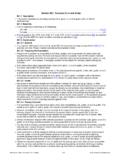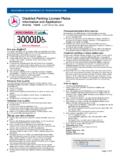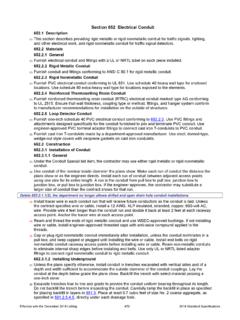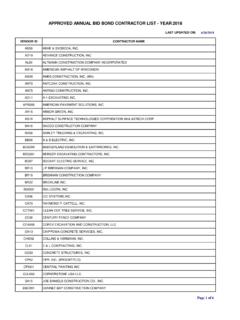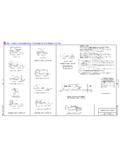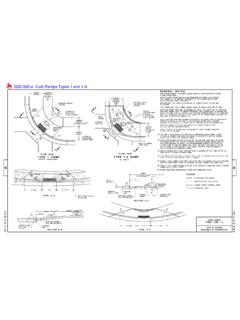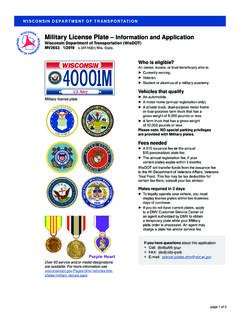Transcription of Chapter 38 Railroad Structures - wisconsindot.gov
1 WisDOT Bridge Manual Chapter 38 Railroad Structures January 2017 38-1 Table of Contents Introduction .. 3 design Specifications and design Aids .. 4 Specifications .. 4 design Aids .. 4 Horizontally Curved Structures .. 4 Railroad Approval of Plans .. 5 design Considerations .. 6 Superstructure .. 6 Methods of design , Selection Type and Superstructure General .. 6 Ballast Floor .. 9 Dead Load .. 9 Live Load .. 10 Live Load Distribution .. 10 Stability .. 12 Live Load Impact .. 12 Centrifugal Forces on Railroad Structures .. 14 Lateral Forces From Equipment .. 14 Longitudinal Forces on Railroad Structures .. 15 Wind Loading on Railroad Structures .. 15 Loads from Continuous Welded Rails .. 16 Fatigue Stresses on Structures .. 16 Live Load Deflection.
2 17 Loading Combinations on Railroad Structures .. 17 Basic Allowable Stresses for Structures .. 17 Length of Cover Plates and Moment Diagram .. 18 Charpy V-Notch Impact Requirements .. 18 Fracture Control Plan for Fracture Critical Members .. 18 Waterproofing Railroad Structures .. 19 Substructure .. 20 Abutments and Retaining Walls .. 20 Piers .. 22 Loads on Piers .. 23 WisDOT Bridge Manual Chapter 38 Railroad Structures January 2017 38-2 Dead Load and Live Loading .. 23 Longitudinal Force .. 23 Stream Flow Pressure .. 23 Ice Pressure .. 23 Buoyancy .. 23 Wind Load on structure .. 23 Wind Load on Live Load .. 24 Centrifugal Force .. 24 Rib Shortening, Shrinkage, Temperature and Settlement of Supports .. 24 Loading Combinations .. 24 Pier Protection for Overpass Structures .
3 26 Pier Protection Systems at Spans Over Navigable Streams .. 26 General .. 26 Types of Construction .. 26 Overpass Structures .. 28 Preliminary Plan Preparation .. 28 Final Plans .. 29 Shoring .. 29 Horizontal and Vertical Clearances .. 29 Horizontal Clearance .. 29 Vertical Clearance .. 29 Compensation for Curvature .. 29 Constructability .. 30 WisDOT Bridge Manual Chapter 38 Railroad Structures January 2017 38-3 Introduction The principles of designing Railroad Structures are similar to those for Structures carrying highways. However, Structures carrying railways have much heavier loadings than those subject to highway loadings due to increased dead load, live load and impact required for railways. The general features of design , loadings, allowable stresses, etc.
4 , for railway Structures are controlled by the specifications of the American Railway Engineering and Maintenance-of-Way Association (AREMA). The different Railroad companies vary somewhat in their interpretation and application of these specifications as stated in the AREMA Manual for Railway Engineering (hereafter referred to as AREMA Manual). Requirements for Railroad Structures vary with the Railroad company whose tracks are carried by the structure , and are sometimes varied by the same company in different locations. The AREMA Manual provides for design of Railroad Structures using Allowable Stress design (ASD) and Load Factor design (LFD) methods. The Load and Resistance Factor design (LRFD) method is currently not used. Designers should bear in mind that specifications were developed for more or less typical conditions.
5 If a structure is unusual in some respects, designers should use their best engineering judgment in selection of proper design criteria. Most Railroad companies permit and prefer high strength bolted or shop welded steel plate girders, reinforced concrete or prestressed concrete members in bridge construction. Safety of the traveler on the highway under the structure and uniformity of track surface dictates that the full ballast section of the railway be carried on the structure . The relatively heavy loadings and high impact factor together with the span and clearance requirements usually found in underpass Structures , practically limit the choice of materials for the superstructure to structural steel. The floor under the ballast may be steel plate or reinforced concrete and the substructures could be reinforced concrete or structural steel as conditions warrant.
6 The AREMA Manual covers all phases of railway design , construction, maintenance and operation. It is divided into sections and chapters. Chapter 8, Concrete Structures and Foundations, governs the design and construction of plain and reinforced concrete members, rigid concrete Structures , retaining walls, pile foundations, substructures of railway Structures , etc. Chapter 15 - Steel Structures , governs the design and construction of steel Railroad Structures . In this Chapter , reference will be made to specific articles of the AREMA Manual as required. The AREMA specifications are revised annually and it is essential that the latest revisions be used. The AREMA Manual is a guideline only and should be followed as a starting point in design .
7 Railroad companies are essentially conservative as their primary interest is the safety of their trains and human lives. Their requirements are usually based upon their operating experience and are set up with that interest in view. WisDOT Bridge Manual Chapter 38 Railroad Structures January 2017 38-4 design Specifications and design Aids Specifications Allowable stresses are provided in different chapters and sections of the AREMA Manual. Refer to the design , construction, maintenance and operation related materials as presented in the stated sections of the following specifications: American Railway Engineering and Maintenance-of-Way Association (AREMA) Manual for Railway Engineering Chapter 8 - Concrete Structures and Foundations Chapter 15 - Steel Structures ( design , Fabrication and Construction) Chapter 28 Clearances - (Horizontal and Vertical) AASHTO Standard Specifications for Highway Bridges, 17th Edition Wisconsin Standard Specifications for Highway and structure Construction design Aids In the design of Railroad Structures the only short cut available is a method of computing Live Load Moments, Shears and Reactions by the use of tables which can be found in Section of Chapter 15, part 1 of the AREMA Manual.
8 This table reflects Cooper E80 Live Loading shown in Figure All the moment, shear and reaction values are for one rail (one-half track load) only and all the values can be prorated (directly proportional) for smaller or larger Cooper's E live loadings. Floor beam spacings in through plate-girder Railroad Structures may be determined by a number of things, but consideration should be given to the transverse stiffener spacings of the girders. It is very convenient to have the floor beam spacing in multiples of stiffener spacings. For ballasted Structures , all lateral forces will be carried by the steel ballast plate which is extremely rigid and lateral bracing will not be required. Horizontally Curved Structures The latest AREMA specifications as well as individual Railroad company s interpretation and application of the AREMA Manual should be followed in designing and detailing curved Structures .
9 There is considerable information available on designing curved steel girders. Most of the methods require computer programs that may be difficult to use. The Approximate Method of design developed by USS Corporation is an accepted approach for horizontally curved girders. WisDOT Bridge Manual Chapter 38 Railroad Structures January 2017 38-5 Railroad Approval of Plans There is a need to get the individual Railroad company s unique design requirements. Smaller companies such as Wisconsin & Southern may rely on AREMA requirements and DOT experience. Prior to starting the preliminary design , the Bureau of Structures (BOS) should receive the Railroad company s current standards and design policy guidelines. Before the preliminary plan is prepared, the Regional Project Manager, BOS and Bureau of Rails and Harbors (BRH) should review the particular Railroad company s design standards for compliance with 23 CFR and DOT policy, and for compatibility and practicality with unique project features.
10 The preliminary structure plan should be prepared and submitted to the Railroad company for approval after the above steps have been completed. Detailed structure design should not begin until the Railroad company has approved the preliminary plan. The bridge designer should work directly with the Railroad s bridge engineering office where interpretation of requirements or clarification of design details is needed. The final structure plan and special provisions need to be sent to and approved by the Railroad company before the project is authorized for letting. WisDOT Bridge Manual Chapter 38 Railroad Structures January 2017 38-6 design Considerations Superstructure Methods of design , Selection Type and Superstructure General The preferred types of Railroad Structures are as follows: Rolled or welded girders for spans of 50 feet or less Bolted or welded plate girders for spans over 50 to 150 feet Bolted or welded trusses for spans over 150 feet The superstructures of grade separations carrying Railroad traffic are usually of beam and girder construction.
